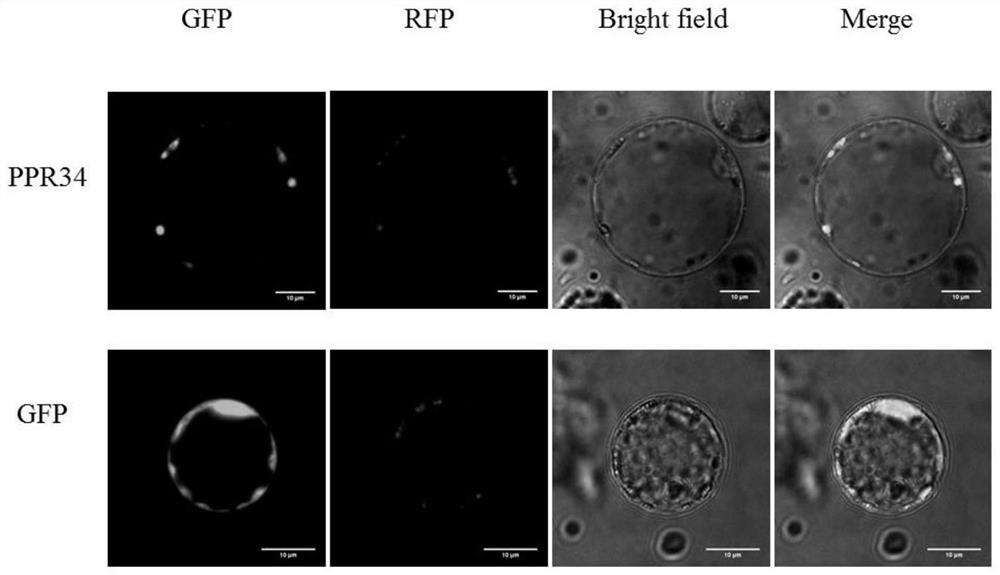Rice OsPPR34 gene as well as encoding protein and application thereof
A technology of gene coding, rice, applied in the field of genetic engineering
- Summary
- Abstract
- Description
- Claims
- Application Information
AI Technical Summary
Problems solved by technology
Method used
Image
Examples
Embodiment 1
[0044] Cloning of embodiment 1 rice OsPPR34 gene
[0045] 1. Seedling cultivation
[0046] The rice variety Nipponbare was germinated at 30°C for 48 hours, and then sowed in the greenhouse. When the rice leaves were 3-5 pieces, the DNA or RNA was ready to be extracted.
[0047] 2. RNA isolation:
[0048] RNA extraction: freeze the sample in a mortar and grind it into a powder, add 1mL TRNzol-A+ reagent to a 2mL EP tube, shake fully, place at room temperature for 5min, then add 0.2mL chloroform, shake vigorously After 15 s, place at room temperature for 3 min; centrifuge at 12,000 rpm for 10 min at 4°C, transfer the supernatant to a new 2 mL EP tube, add an equal volume of isopropanol to precipitate RNA, and add 100 μL RNase-free ddH2O to dissolve. The quality of total RNA was identified by electrophoresis, and then the RNA content was determined on a spectrophotometer.
[0049] 3. Synthesis of first-strand cDNA by reverse transcription
[0050] (1) Before reverse transcrip...
Embodiment 2
[0061] Example 2 Protein sequence information and homology analysis of rice OsPPR34
[0062] According to the ORF of the new rice OsPPR34 (gene number: Os07g0598500 / LOC_Os07g40750) of the present invention, the amino acid sequence of rice OsPPR34 is deduced, with a total of 506 amino acids and a molecular weight of 56520 Daltons. See SEQ ID NO: 4 for the detailed sequence. According to the BLASTP program on the NCBI website (https: / / blast.ncbi.nlm.nih.gov / Blast.cgi), the OsPPR34 protein has a typical P domain and belongs to the P subfamily of the PPR protein family.
[0063] Through multiple sequence alignment of some PPR-encoded proteins in plants, we found that these proteins all contain a conserved PPR domain ( figure 1 ).
Embodiment 3
[0064] Example 3 Creation of Rice Gene OsPPR34 Knockout Mutant
[0065] 1. Using CRISPR-Cas9 technology to construct a multi-target knockout vector containing OsPPR34:
[0066] (1) Guide RNA target sequence selection and primer design
[0067] According to the genome sequence of OsPPR34 (gene number: Os07g0598500 / LOC_Os07g40750), two sgRNAs were designed. 20nt nucleotide sgRNA target sequence according to 5'-GN 19 NGG-3' (SEQ ID NO:5) sequence was designed, and the target sequence primers PPR34-gRT+ and PPR34-OsU6aT- were designed at the same time, with 15-17 nt at the 3' end paired with the sgRNA and U6a promoters respectively. The designed sgRNA target sequence was compared with the rice genome database to exclude non-specific target cutting sites. The specific target nucleotide sequence is as follows.
[0068] PPR34-1-gRT+:5'-AAGGATCACGCTGTTCACCgttttagagctagaaat-3', SEQ ID NO:6;
[0069] PPR34-1-OsU6aT-:5'-GGTGAACAGCGTGATCCTTCggcagccaagccagca-3', SEQ ID NO:7;
[0070] ...
PUM
| Property | Measurement | Unit |
|---|---|---|
| Top diameter | aaaaa | aaaaa |
| Bottom diameter | aaaaa | aaaaa |
| Height | aaaaa | aaaaa |
Abstract
Description
Claims
Application Information
 Login to View More
Login to View More - R&D
- Intellectual Property
- Life Sciences
- Materials
- Tech Scout
- Unparalleled Data Quality
- Higher Quality Content
- 60% Fewer Hallucinations
Browse by: Latest US Patents, China's latest patents, Technical Efficacy Thesaurus, Application Domain, Technology Topic, Popular Technical Reports.
© 2025 PatSnap. All rights reserved.Legal|Privacy policy|Modern Slavery Act Transparency Statement|Sitemap|About US| Contact US: help@patsnap.com



